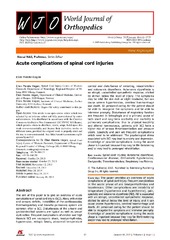| dc.contributor.author | Hagen, Ellen Merete | en_US |
| dc.date.accessioned | 2016-08-02T11:18:28Z | |
| dc.date.available | 2016-08-02T11:18:28Z | |
| dc.date.issued | 2015 | |
| dc.Published | World Journal of Orthopaedics 2015, 6(1):17-23 | eng |
| dc.identifier.issn | 2218-5836 | |
| dc.identifier.uri | https://hdl.handle.net/1956/12386 | |
| dc.description.abstract | The aim of this paper is to give an overview of acute complications of spinal cord injury (SCI). Along with motor and sensory deficits, instabilities of the cardiovascular, thermoregulatory and broncho-pulmonary system are common after a SCI. Disturbances of the urinary and gastrointestinal systems are typical as well as sexual dysfunction. Frequent complications of cervical and high thoracic SCI are neurogenic shock, bradyarrhythmias, hypotension, ectopic beats, abnormal temperature control and disturbance of sweating, vasodilatation and autonomic dysreflexia. Autonomic dysreflexia is an abrupt, uncontrolled sympathetic response, elicited by stimuli below the level of injury. The symptoms may be mild like skin rash or slight headache, but can cause severe hypertension, cerebral haemorrhage and death. All personnel caring for the patient should be able to recognize the symptoms and be able to intervene promptly. Disturbance of respiratory function are frequent in tetraplegia and a primary cause of both short and long-term morbidity and mortality is pulmonary complications. Due to physical inactivity and altered haemostasis, patients with SCI have a higher risk of venous thromboembolism and pressure ulcers. Spasticity and pain are frequent complications which need to be addressed. The psychological stress associated with SCI may lead to anxiety and depression. Knowledge of possible complications during the acute phase is important because they may be life threatening and/ or may lead to prolonged rehabilitation. | en_US |
| dc.language.iso | eng | eng |
| dc.publisher | Baishideng Publishing Group | eng |
| dc.rights | Attribution CC BY-NC | eng |
| dc.rights.uri | http://creativecommons.org/licenses/by-nc/4.0/ | eng |
| dc.subject | Spinal cord injuries | eng |
| dc.subject | Autonomic dysreflexia | eng |
| dc.subject | Cardiovascular disease | eng |
| dc.subject | Orthostatic hypotension | eng |
| dc.subject | Bradycardia | eng |
| dc.subject | Thromboembolism | eng |
| dc.subject | Respiratory insufficiency | eng |
| dc.title | Acute complications of spinal cord injuries | en_US |
| dc.type | Peer reviewed | |
| dc.type | Journal article | |
| dc.date.updated | 2016-04-11T12:47:22Z | |
| dc.description.version | publishedVersion | en_US |
| dc.rights.holder | Copyright 2015 The Authors | |
| dc.identifier.doi | https://doi.org/10.5312/wjo.v6.i1.17 | |
| dc.identifier.cristin | 1224685 | |

